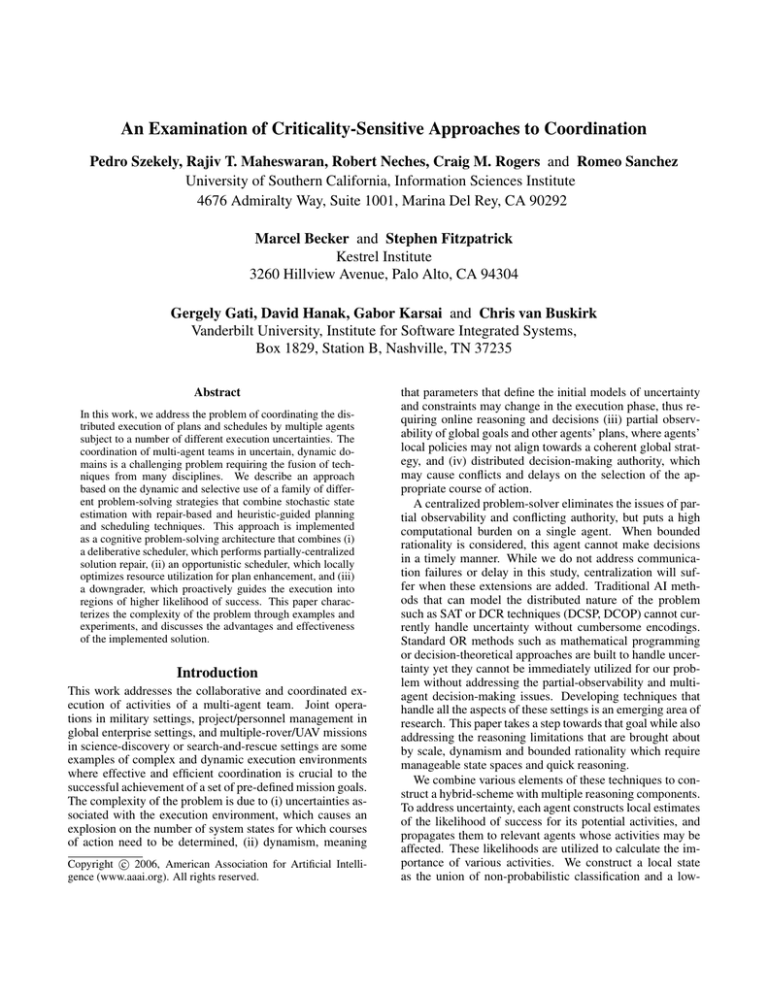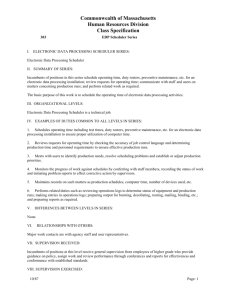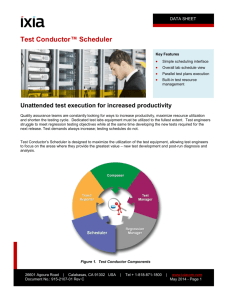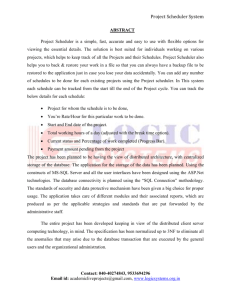
An Examination of Criticality-Sensitive Approaches to Coordination
Pedro Szekely, Rajiv T. Maheswaran, Robert Neches, Craig M. Rogers and Romeo Sanchez
University of Southern California, Information Sciences Institute
4676 Admiralty Way, Suite 1001, Marina Del Rey, CA 90292
Marcel Becker and Stephen Fitzpatrick
Kestrel Institute
3260 Hillview Avenue, Palo Alto, CA 94304
Gergely Gati, David Hanak, Gabor Karsai and Chris van Buskirk
Vanderbilt University, Institute for Software Integrated Systems,
Box 1829, Station B, Nashville, TN 37235
Abstract
In this work, we address the problem of coordinating the distributed execution of plans and schedules by multiple agents
subject to a number of different execution uncertainties. The
coordination of multi-agent teams in uncertain, dynamic domains is a challenging problem requiring the fusion of techniques from many disciplines. We describe an approach
based on the dynamic and selective use of a family of different problem-solving strategies that combine stochastic state
estimation with repair-based and heuristic-guided planning
and scheduling techniques. This approach is implemented
as a cognitive problem-solving architecture that combines (i)
a deliberative scheduler, which performs partially-centralized
solution repair, (ii) an opportunistic scheduler, which locally
optimizes resource utilization for plan enhancement, and (iii)
a downgrader, which proactively guides the execution into
regions of higher likelihood of success. This paper characterizes the complexity of the problem through examples and
experiments, and discusses the advantages and effectiveness
of the implemented solution.
Introduction
This work addresses the collaborative and coordinated execution of activities of a multi-agent team. Joint operations in military settings, project/personnel management in
global enterprise settings, and multiple-rover/UAV missions
in science-discovery or search-and-rescue settings are some
examples of complex and dynamic execution environments
where effective and efficient coordination is crucial to the
successful achievement of a set of pre-defined mission goals.
The complexity of the problem is due to (i) uncertainties associated with the execution environment, which causes an
explosion on the number of system states for which courses
of action need to be determined, (ii) dynamism, meaning
c 2006, American Association for Artificial IntelliCopyright gence (www.aaai.org). All rights reserved.
that parameters that define the initial models of uncertainty
and constraints may change in the execution phase, thus requiring online reasoning and decisions (iii) partial observability of global goals and other agents’ plans, where agents’
local policies may not align towards a coherent global strategy, and (iv) distributed decision-making authority, which
may cause conflicts and delays on the selection of the appropriate course of action.
A centralized problem-solver eliminates the issues of partial observability and conflicting authority, but puts a high
computational burden on a single agent. When bounded
rationality is considered, this agent cannot make decisions
in a timely manner. While we do not address communication failures or delay in this study, centralization will suffer when these extensions are added. Traditional AI methods that can model the distributed nature of the problem
such as SAT or DCR techniques (DCSP, DCOP) cannot currently handle uncertainty without cumbersome encodings.
Standard OR methods such as mathematical programming
or decision-theoretical approaches are built to handle uncertainty yet they cannot be immediately utilized for our problem without addressing the partial-observability and multiagent decision-making issues. Developing techniques that
handle all the aspects of these settings is an emerging area of
research. This paper takes a step towards that goal while also
addressing the reasoning limitations that are brought about
by scale, dynamism and bounded rationality which require
manageable state spaces and quick reasoning.
We combine various elements of these techniques to construct a hybrid-scheme with multiple reasoning components.
To address uncertainty, each agent constructs local estimates
of the likelihood of success for its potential activities, and
propagates them to relevant agents whose activities may be
affected. These likelihoods are utilized to calculate the importance of various activities. We construct a local state
as the union of non-probabilistic classification and a low-
dimensional probabilistic state vector denoted as a profile.
The reasoning is performed by three components: (1) the
deliberative scheduler, (2) the opportunistic scheduler, and
(3) the downgrader. The deliberative scheduler performs dynamic partial-centralization of the relevant agents when a
problem is detected in some substructure of the team reward.
It then extracts potential solutions and proposes modifications to remedy the problem. Due to the complexity of this
task and the nature of the anticipated failure, this process
occurs over several decision epochs with decision windows
that begins slightly in the future. The opportunistic scheduler performs schedule modifications in the near-term. Using only local information, it is capable of making decisions
on a faster time-scale, and attempts to increase the quality
and probability of success by utilizing free resources. The
downgrader complements the previous two components by
freeing resources both in the near-term and the future based
on the evolution of the system up to the present.
Model
We model our problem with CTAEMS, which is an adaptation of the TAEMS formulation (Decker & Lesser 1993)
representing distributed multi-agent coordination problems.
In this formulation, each agent has the potential to execute a
set of activities or methods over a finite time horizon broken
up into decision epochs. Once an agent starts a method, it
can either abort it or wait for its completion in order to start
another method. Each method produces some quality and
takes a duration. These quantities are drawn from probability distributions. Failure occurs when a method yields zero
quality. A failure is modeled when quality zero is listed in
its probability distribution with non-zero probability. Otherwise, it is an unmodeled failure. Each method belongs to
a window that prescribes the earliest time at which it may
begin and the latest time at which it may complete in order
to obtain positive quality.
The qualities achieved by the executed methods are aggregated through a tree of quality accumulation functions
(QAFs) to yield the reward for the multi-agent team. This
tree consists of a hierarchy of nodes, where each leaf node
represents a method associated to a single agent that can execute it. The non-leaf nodes are tasks with associated QAFs
that define their quality as a function of the qualities of the
children. The children of a task can be methods or tasks.
This hierarchy defines how the quality of the root node, the
team reward, is computed from the individual methods that
agents execute.
The QAFs include: (i) MIN, which yields the minimum
value of qualities of the children, used to model situations
where all children must succeed in order for the parent to
accumulate quality. (ii) MAX, which yields the maximum
value of qualities of the children, used to model situations
where at least one of the children must achieve positive quality. (iii) SUM, which adds the qualities of the children, also
used to model situations where some children must succeed. (iv) SyncSUM, which adds the qualities of the children whose start time is the earliest start time of all children.
This encourages child nodes to align their execution to begin
at the same time.
An additional complexity is the possibility of non-local
effects (NLEs) between nodes. An NLE is an enabling coupling between nodes, a directed link between a source and a
target. Targets started before all sources have accumulated
quality will fail and accumulate zero quality regardless of
the their probability distributions. If the target is a task, the
NLE applies to all descendant nodes.
The challenge for the multi-agent team is to make the appropriate choices of methods to execute that yield the highest quality at the root of the CTAEMS hierarchy. Effective
policies must react dynamically to the uncertainties in the
durations and qualities of methods in an initial schedule and
create new schedules as the sample path unfolds. Reacting
to the state of the system is made more difficult by the fact
that agents cannot see the entire CTAEMS hierarchy. Agents
have a subjective view consisting of the methods they can
execute and their direct ancestry to the root node along with
nodes that are one-step removed due to NLEs. This models the partial-observability inherent in multi-agent systems
where an agent cannot monitor the entire system and often
is not aware of certain parts of the team. This aspect occurs
to a greater extent in large-scale settings.
Example
In order to illustrate our model, and part of the complexity
of the problem, we discuss an example in this section. The
CTAEMS structure for our example can be seen in Figure 1.
This problem consists of three phases (or windows), denoted as setup, deploy and engage modeled using SUM
QAFs. Each window has two different MAX tasks, each
with two children methods. The problem has two agents,
alpha and bravo. Each method belongs either to plan A or
plan B. The root, S1 , is a MIN QAF, requiring each phase
(window) to produce quality in order for the overall problem to succeed. Figure 1 shows the enabling relationships
among different methods. For example, method p1a A enables method p2a A, which implies that p1a A must execute
successfully before method p2a A is worth starting.
The layout of Figure 2 illustrates some of the complexities of the problem. For simplicity, each method has been
labeled with the information regarding the schedule where
it participates, and the agent who executes it. Bars correspond to the probability distribution for the durations of each
method, here having three outcomes. Plan A is the initial
schedule, which leads to a higher accumulated quality but it
is somewhat risky, since its activities may take longer. On
the other hand, plan B produces less quality but it is safer.
Note that uncertainty in the method durations can lead to
failures. Furthermore, enabling dependencies increase the
probability of failure for future phases of the problem. We
can see an example of such failing conditions in Figure 3.
Here, Plan A gets delayed given that the setup phase activities take their maximum duration. Consequently, agent
alpha cannot complete its method by the deadline during
the deploy phase. The failure in the deploy phase along with
other enabling conditions preclude the activities in the final
engage phase of the problem which prevents the team from
accumulating quality.
Figure 1: CTAEMS Example Structure
Figure 2: Time Uncertainty in Example
Figure 3: Failing Execution Trace
Our system can predict failures, and trigger timely schedule repairs. Determining when to act in uncertain and distributed domains is inherently complex. The general idea is
to detect potential problems in the schedule early, in order to
have enough lead time to schedule and execute the enablers
of methods needed to repair problems later on. Consider
again Figure 3. Once the method in the setup window hits
its maximum duration, the probability that the alpha agent
completes its method on time during the deploy phase decreases (i.e, only two outcomes will allow completion before
the deadline). Note that this has a cascading effect, since the
probabilities of success for the activities in the engage phase
depend on the success of activities in the deploy phase. A
solution to our example is to anticipate the potential failure
in plan A and switch to plan B during the second phase as
illustrated in Figure 4.
In the following sections, we present our approach for dynamically detecting and repairing potential failures on the
schedule based on the probability of success of each method,
and its importance with respect to the success of the overall
plan.
Approach
Our approach involves the selective combination of different
problem solving strategies, including partially-centralized
solution repair (deliberative scheduler), locally optimized
resource allocation (opportunistic scheduler) and proactive
re-prioritization (downgrader). These higher-level reasoning components are triggered and supported by a state manager which holds schedules and profiles and an execution
controller which interacts with the environment and trans-
erative scheduler can create a set of schedule changes that
are installed on remote agents. To reduce the potential conflicts during remote schedule updates running in parallel, a
locking mechanism is in place that serializes the distributed
installation of schedules.
Figure 4: Execution Trace of Plan B
lates our strategies into actions. The architecture of the CSC
coordinator can be seen in Figure 5.
State Manager and Execution Controller
State Manager The purpose of the state manager is to
give the reasoning components the information they need
to act. There are essentially two types of such information: probabilities and importance, denoted by p and α respectively in Figure 5. Both types of information are kept
about the current schedule and about potential schedules
that the agents may engage. The probabilities about the
current schedule enable agents to determine whether they
should change the current schedule. The importance allows
them to determine the marginal contribution that any individual method has on the success probability of the current
schedule. The potential probabilities allow agents to reason
about the probability improvements that could be achieved
by engaging new options. The potential importance allows
agents to determine whether methods can still contribute to
the overall quality of the schedule.
The probability and importance of current and potential schedules are global quantities that, in general, depend
on the local state of all agents. We have developed distributed algorithms that compute approximations of these
values based on local information and approximations received from other agents. The state manager uses these algorithms and the protocols to share local information with
other agents.
Schedule The system stores the current schedule in a distributed manner as part of the state graphs maintained by the
State Manager instance on each agent. Every method has an
associated scheduled start window and a priority. At the beginning of a simulation, these are determined based on the
initial schedule contained in the initial subjective view of an
agent. At runtime, the downgrader, the opportunistic and
deliberative schedulers alter the current schedule by modifying the start windows and priorities of scheduled methods
or by adding new methods to the schedule. The first two
schedulers operate only on local methods while the delib-
Profiles Profiles are designed to reason about uncertainty,
and contain (i) a pair representing probability and busycycles of a CTAEMS node and (ii) an importance value.
These measures are used to evaluate the current and potential
schedules. For the current schedule, probabilities for methods are calculated using information about the distributions
of durations and their execution windows. In addition, we
factor in the probabilities of enabling methods. The busycycles are a resource consumption measure also calculated
from the duration distributions. These pairs are propagated
throughout the system via nearest neighbor communication.
Using these probabilities, we can calculate the importance
of each node to the overall system performance based on the
importance values in the local view of each node, again in a
distributed manner. The potential profiles consist of a single
pair for the methods denoting the likelihood and costs independent of the current schedule and a set of pairs for higher
nodes, which represent potential solutions for achieving positive quality at that node. We use these profiles to obtain
potential importance, which determines if a method or node
can still contribute to helping the team goal succeed. As in
the case of the scheduled profiles and importance, the potential measures are propagated in a distributed manner through
communication to relevant neighbors.
Execution Controller The execution controller manages
the flow of data between the agent and the underlying execution or simulation environment, including inter-agent messaging. It converts execution environment events, such as
method start and stop, into a platform-neutral representation for portability. It runs at a higher priority level than the
rest of the agent and avoids priority inversions when accessing shared data, allowing it to continue to execute scheduled
methods even when the rest of the agent lags behind the pace
of execution environment events.
The execution controller contains its own distributed
window-sliding scheduler. A scheduled method’s execution
will be delayed until its enabling conditions are met, even
if some enabling conditions depend upon the state of methods residing in other agents; the necessary inter-agent communications will take place autonomously between execution controller instances. A method will be dropped from
the schedule when one or more of its enabling conditions
has failed. When a set of methods is to be initiated synchronously on a set of agents, the execution controllers will
communicate to ensure that synchronized execution takes
place in the execution environment once all enabling conditions have been met.
Higher-Level Reasoning Components
Deliberative Scheduler The CTAEMS task structure provides a hierarchical representation for the entire family of
possible schedules for a particular input scenario or prob-
Deliberative
Scheduler
Opportunistic
Scheduler
Downgrader
P, α
Coordination
Reasoners
P, α
Schedule
P, α
Remote
P, α
P, α
Local
State
Options
State Manager
Execution Controller
P, α
Environment
Figure 5: CSC Architecture
lem. The scheduler component is responsible for traversing
this hierarchy and selecting the set of methods, or activities,
that should be executed by the different agents with the goal
of maximizing global task quality. Method execution is constrained by feasibility intervals, scenario specific restrictions
on earliest method start and latest method finish times; single threadedness, each agent can only execute one method
at a time; method interactions, dependencies on the order of
execution of certain methods.
The scheduler is implemented as a configurable, heuristicguided search engine that traverses the task hierarchy defined in the CTAEMS problem description provided as input, selects a set of methods to execute, and assigns starttime windows for methods in this set. The search tree expanded by the search engine follows the topology of the task
structure defined in the CTAEMS structure: starting from a
pre-defined root node, the algorithm recursively expands the
search tree for the children of the selected node. The order in which the children of a particular node are selected,
the strategy used to expand the sub-tree, the allocation of
agent’s time for method execution, and the metric used to
select the results for different types of nodes is parameterizable. The cognitive problem solving mechanism uses several
different pre-configured search strategies: fast repair-based
strategies that only try to fill existing gaps in agent’s availability, load balance techniques that try to guarantee minimum amounts of positive quality for certain tasks, robustness enhancement strategies that schedules redundant methods to increase probability of positive quality achievement,
and schedule compression techniques combined with some
other strategy to reduce agent’s idle time and increase expected quality.
The different agents participating in the execution do not
have a complete view of the task network. Each agent owns
a subset of all the methods and tasks, and can only see the
constraints and nodes directly affecting the owned node. In
response to scheduling decisions, or execution events, each
agent perform propagation on its local constraint network.
This will cause modifications to both owned and visible
nodes. It then sends to other remote agents the changes on
its owned nodes. When receiving this information, remote
agents update their local views or the other agent’s node,
and perform constraint propagation to keep the state of their
owned nodes consistent. The updated state of owned nodes
for each agent is then sent to other agents, until there are not
more modifications in the state of owned nodes. If, during
propagation, an agent detects conflicts involving one of its
owned nodes, this agent is responsible for resolving the conflict. At this point, the agent may then trigger more complex
problem-solving components that would require the creating of a cluster of agent to solve the problem in a partially
centralized fashion.
Opportunistic Scheduler The opportunistic scheduler is
instantiated whenever there is a gap where an agent is not
performing a high priority method. At this point, the agent
estimates the window of available resource, namely execution time before the next high priority method is scheduled
to begin. The agent then may choose to begin executing a
method that is not part of the current schedule. The goal
is to choose the best method to execute given the resource
restrictions, without harming the existing schedule. Using
local knowledge of the reward function and methods scheduled to be executed, the agent dismisses methods that may
cause harm should they get aborted by higher priority methods introduced by the deliberative scheduler. Then, the opportunistic scheduler utilizes the probabilities and importance measures in the profile to determine the method with
the greatest likelihood of helping the team. This method is
inserted with medium priority such that any (existing or future) alterations to the schedule by the deliberative scheduler
are not affected. Every agent runs an opportunistic scheduler
to maximize the use of its execution capabilities.
Downgrader The downgrader utilizes the potential importance to determine whether methods in the schedule can
still contribute to the team goal. The priorities of methods
are reduced if it is determined that they no longer can contribute, freeing agent resources for other scheduler components that schedule methods at higher priority. Downgrading gives methods installed by the deliberative scheduler a
higher likelihood of succeeding by removing unimportant
methods that start earlier, and gives the opportunistic scheduler more chances to be instantiated. The preceding effects
serve to enhance the robustness of the system.
problems in which our system produces a reduction in quality over the base system. However, we can see that for most
of the problems our system consistently returns better quality solutions, anticipating and recovering from failures, and
generating alternative schedules.
Figure 6: Quality Improvement Over Base System
Experiments
Related Work
We have described in previous sections the main components of our system to handle distributed scheduling problems under uncertainty, dynamism, temporal constraints and
partial observability. One remaining challenge is to produce
a set of experiments that could meaningfully test our system, despite the complexity and quantity of interactions in
the problem. Our aim is to introduce a set of problems that
share some systematic structure in order to present some
preliminary evaluation of our work. In particular, we have
designed our problems taking into account two important
factors: NLE chains and failure rate. Each factor has been
categorized into four subclasses: empty, low, medium and
high. Each subclass relates to the number of NLE chains
or failures introduced into a particular problem. The entire
problem space is then partitioned as a cross product of the
factors and their subclasses. Finally, each subspace of problems is built using an increasing degree of window overlap.
NLEs and failures are introduced randomly for each problem, all of which have four agents for the purpose of this
evaluation.
Our testing platform includes a cluster of distributed 32bit Intel Linux systems with at least 1.5GB of memory. One
of them serves as the simulation controller and the rest are
assigned to agents.
Figure 6 displays a plot with our solutions. The plot
shows the difference in quality between our base system and
our higher-level reasoning enhancements. The data points
represent average results over ten trials per problem, under different random seeds. Each problem is provided with
an initial schedule, that may fail in accordance to a failure
probability distribution. Negative data points illustrate those
The coordination of multi-agent systems in dynamic,
stochastic, temporally-constrained and partially observable
domains is a challenging problem. The most general
decision-theoretic models for this problem have been proved
to be extremely complex (NEXP-complete) (Shen, Becker,
& Lesser 2006). In order to lower complexity, some models restrict the types of interactions allowed in the system, or the features they are able to address. One of
such models is DEC-MDP (Goldman & Zilberstein 2003;
Beynier & Mouaddib 2005). The decentralized MDP model
usually bases its computation on local policies, with very little or no communication among agents (Beynier & Mouaddib 2005). Although, our approach also computes local estimates of the probability of success for each activity, such
estimates are propagated in a distributed manner to the interacting agents.
Another way of modeling the multi-agent coordination
problem is through traditional AI methods. Distributed Constraint Optimization Problems (DCOP) have been adapted
to capture the locality of interactions among agents with a
small number of neighbors (Cox, Durfee, & Bartold 2005),
but it fails to capture the uncertainty factor in the general
problem. Network Distributed POMDPs have been proposed to address these issues (Nair et al. 2005). Unfortunately, they solve only small problems.
Decision-theoretic planning can also be used to model
our problem (Littman, Goldsmith, & Mundhenk 1998). In
this model, execution monitoring of the system and replanning are very important. Conditional plans are generated
in order to deal with contingencies during execution. Replanning is invoked when an agent identifies unsatisfied,
or likely to fail conditions. However, the requirements for
a rich model for actions and time are generally problematic for planning techniques based on MDP, POMDP, SAT,
CSP, planning graphs or state space encodings (Bresina et al.
2002). Finally, scalability is also an issue given the size of
the problem and the number of potential contingencies. Our
approach tries to alleviate these problems by being proactive, and focusing on activities with high probability of failure. Some other techniques that follow similar reasoning
are Just-In-Case (JIC) contingency scheduling (Drummond,
Bresina, & Swanson 1994) and Mahinur (Onder & Pollack
1999).
Conclusion
Preliminary evaluation indicates that the full CSC system
significantly outperforms the baseline both in terms of the
average quality of schedule execution (see Figure 6) and
in terms of avoidance of schedule execution failures. The
preliminary ablation studies show no significant difference
in the scores obtained using the deliberative scheduler only,
the opportunistic scheduler only or the deliberative and opportunistic scheduler together. The deliberative and opportunistic schedulers use very different approaches, so we are
surprised to see no significant difference in their scores. We
speculate that the structure of the problems is such that both
approaches identify similar solutions. In order to verify this
hypothesis, we are now conducting experiments to analyze
the detailed behavior of the system on specific problem instances. We are also working on a range of evaluation tools
ranging from problem generators, visualization tools and
centralized algorithms to compute benchmark scores.
Acknowledgments
The work presented here is funded by the DARPA COORDINATORS Program under contract FA8750-05-C-0032.
The U.S.Government is authorized to reproduce and distribute reports for Governmental purposes notwithstanding
any copyright annotation thereon. The views and conclusions contained herein are those of the authors and should
not be interpreted as necessarily representing the official
policies or endorsements, either expressed or implied, of
any of the above organizations or any person connected with
them.
References
Beynier, A., and Mouaddib, A. 2005. A polynomial algorithm for decentralized markov decision processes with
temporal constraints. In Proceedings of the 4th International Joint Conference on Autonomous Agents and Multi
Agent Systems(AAMAS-05).
Bresina, J.; Dearden, R.; Meuleau, N.; Smith, D.; and
Washington, R. 2002. Planning under continuous time and
resource uncertainty: A challenge for ai. In Proceedings of
UAI.
Cox, J.; Durfee, E.; and Bartold, T. 2005. A distributed framework for solving the multiagent plan coordination problem. In Proceedings of the 4th International
Joint Conference on Autonomous Agents and Multi Agent
Systems(AAMAS-05), 821–827.
Decker, K., and Lesser, V. 1993. Quantitative modeling of
complex computational task environments. In Proceedings
of the 11th National Conference on Artificial Intelligence
(AAAI-93), 217–224.
Drummond, M.; Bresina, J.; and Swanson, K. 1994. Justin-case scheduling. In Proceedings of the 12th National
Conference on Artificial Intelligence (AAAI-94), 1098–
1104.
Goldman, C., and Zilberstein, S. 2003. Optimizing information exchange in cooperative multi-agent systems. In
Proceedings of the Second International Joint Conference
on Autonomous Agents and Multi Agent Systems(AAMAS03), 137–144.
Littman, M.; Goldsmith, J.; and Mundhenk, M. 1998. The
computational complexity of probabilistic planning. Artificial Intelligence Research (JAIR) 9:1–36.
Nair, R.; Varakantham, P.; M.‘Tambe; and Yokoo, M.
2005. Networked distributed pomdps: A synthesis of
distributed constraint optimization and pomdps. In Proceedings of the 4th International Joint Conference on Autonomous Agents and Multi Agent Systems(AAMAS-05).
Onder, N., and Pollack, M. 1999. Conditional, probabilistic planning: A unifying algorithm and effective search
control mechanisms. In Proceedings of the 16th National
Conference on Artificial Intelligence (AAAI-99), 577–584.
Shen, J.; Becker, R.; and Lesser, V. 2006. Agent Interaction
in Distributed MDPs and its Implications on Complexity.
In Proceedings of the Fifth International Joint Conference
on Autonomous Agents and Multi-Agent Systems.






